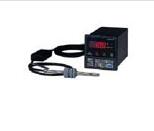Limiting Current Type Oxygen Analyzer OX102
he OX102 Oxygen Analyzer measures oxygen concentration from ppm to percent levels in a single analyzer and is ideal for ppm-level measurements in applications such as nitrogen reflow furnaces and semiconductor plants.
The zirconia oxygen sensor uses a method that is based on the limiting current principle and is compact, yet has high-performance. The sensor is designed for installation by direct insertion
When a sample gas contains organic solvent at a few ppm to percent level in applications such as nitrogen reflow furnaces, an optional sampling unit is required.
The OX102 Oxygen Analyzer measures oxygen concentration from ppm to percent levels in a single analyzer and is ideal for ppm-level measurements in applications such as nitrogen reflow furnaces and semiconductor plants.
The zirconia oxygen sensor uses a method that is based on the limiting current principle and is compact, yet has high-performance. The sensor is designed for installation by direct insertion
When a sample gas contains organic solvent at a few ppm to percent level in applications such as nitrogen reflow furnaces, an optional sampling unit is required.
One instrument capable of measuring from 0 - 100 ppm to 0 - 25% oxygen
Simple one touch calibration
Self diagnostics assure high reliability
One touch sensor replacement
Compact size
Measuring Principle
Current flowing in the Zirconia fixed electrolyte causes oxygen to move from the negative to positive electrode (acts as an oxygen pump). If the flow of oxygen to the negative electrode is restricted by the alumina substrate then a current saturation area is created and the same current flows regardless of the applied voltage. The current that flows is called the limiting current. When a fixed voltage is applied, the current flow is proportional to the oxygen concentration.

Applications
N2 reflow furnaces
Semiconductor maker environmental monitoring
ppm-level O2 measurement
Monitoring purity of N2, Ar separated from air
Monitoring for deficiency of O2
| Measured gas | O2 in N2 or mixed gases; cannot be used with silicone vapor, combustible gases and organic solvents |
| Measurement principle | Zirconia limiting current method |
| Measuring range | 0 - 100 ppm/0 - 1000 ppm/0 - 10000 ppm/0 - 25%, automatic/fixed switching mode |
| Sampling method | Natural diffusion system. If the sampled gas may include organic solvents, use a sampling unit. |
| Sample gas conditions | Temperature; 0 to 70℃ Humidity; 0 to 80%RH Pressure; 1013±40 hPa(Abs) |
| Output signal | 1. 4-20 mA DC isolated, fixed range(0 - 100, 0 - 1000, 0 - 1000 ppm, 0 - 25% selectable), or 4 - 20 mA DC autoranging 2. 1 to 5 V DC fixed range(0-100, 0-1000, 0-10000 ppm, 0-25% selectable) 3. Zone signal output for 4 - 20 mA DC autoranging |
| Contact output | 2 outputs |
| Alarm output | High or Low alarm |
| Calibration | a. Atmospheric air one-point calibration : 15 to 25% O2 range b. One-point calibration at 100 ppm : 80 to 120 ppm O2 range c. One-point calibration at 1000 ppm : 900 to 1100 ppm O2 range d. One-point calibration at 10000 ppm : 8500 to 9500 ppm O2 range e. Complete calibration : with air, 20, 100, 500, 1000, 10000 ppm in that order |
| Extension cable | 4 m, 9 m, 29 m |
| Power supply | 100 to 240 V AC, 50/60 Hz, approx. 15 W |
| Converter size | 96(W) x 96(H) x 190(D) mm |
| Repeatability | ±15 ppm O2( Meas. range: 20 to 100ppm) ±25 ppm O2( Meas. range: 100 to 1000 ppm) ±0.3% of reading( Meas. range: 1000 to 5000 ppm) ±7.5% of reading( Meas. range: 5000 to 10000 ppm) ±0.25% O2( Meas. range: 1 to 25%) |



